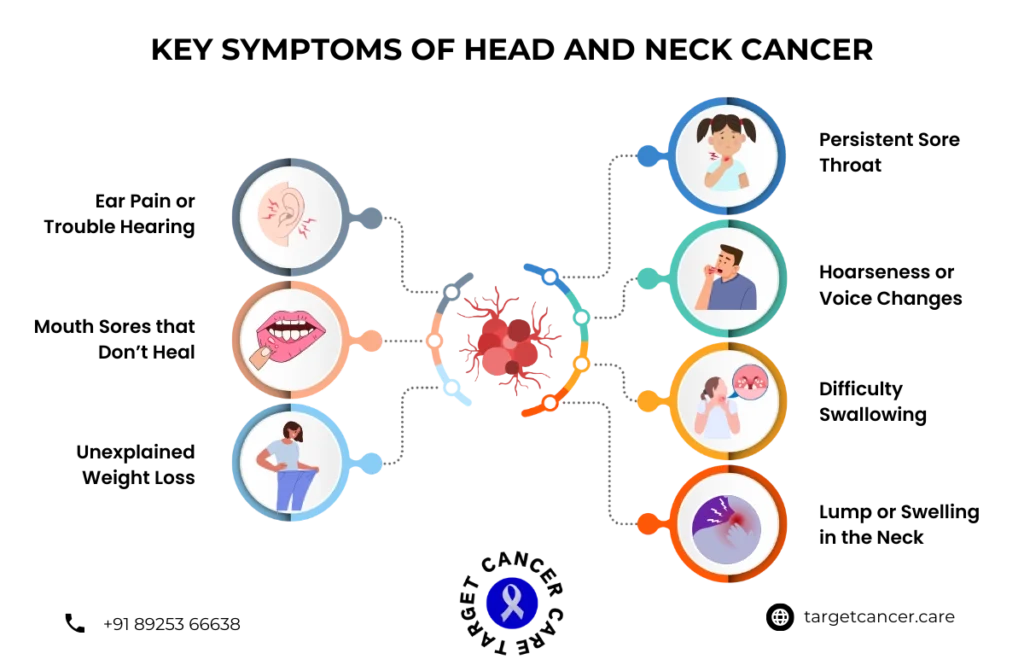Head and neck cancers are a group of cancers that begin in the tissues or organs of the head and neck region. These cancers often develop in the mouth, throat, larynx, sinuses, or nasal cavity. Early detection and proper head and neck cancer treatment are essential to improving outcomes and survival rates. In this blog, we will explore the causes, symptoms, treatment options, and prevention strategies related to head and neck cancers.
What is Head and Neck Cancer?
Head and neck cancer refers to a broad category of cancers that arise from various parts of the head and neck region. These cancers can form in the mucosal surfaces of the nose, mouth, and throat. They are often grouped together due to their shared causes and treatment approaches.
Types of Head and Neck Cancers
Head and neck cancers are classified based on their origin. Some of the most common types include:
- Oral Cancer: Cancer that affects the mouth, including the lips, gums, tongue, roof, and floor of the mouth. Symptoms include sores, difficulty swallowing, or persistent mouth pain.
- Throat Cancer (Pharyngeal Cancer): Includes cancers in the throat, such as the nasopharynx (upper throat), oropharynx (middle throat), and hypopharynx (lower throat). It can cause hoarseness, difficulty swallowing, and pain.
- Laryngeal Cancer (Voice Box Cancer): Affects the larynx, which is responsible for speech. Symptoms often include hoarseness, a persistent cough, and difficulty breathing.
- Nasal and Paranasal Sinus Cancer: Involves cancer in the nasal cavity or sinuses. Symptoms may include nasal congestion, bleeding, or facial pain.
- Salivary Gland Cancer: Affects the glands that produce saliva, often presenting as swelling or a lump near the jaw, mouth, or neck.
- Esophageal Cancer: Cancer of the esophagus, which can cause difficulty swallowing, chest pain, and weight loss.
- Thyroid Cancer: Although part of the neck, thyroid cancer is often classified separately. Symptoms may include a lump in the neck or changes in voice.
- Skin Cancer (Skin of the Face and Neck): Includes squamous cell carcinoma and basal cell carcinoma, which can appear as sores, growths, or changes in skin texture.
Reconstructive Surgery for Head and Neck Cancer Patients may be needed depending on the location and size of the tumor removed.
Symptoms and Causes
Recognizing the early signs of head and neck cancer is crucial for timely intervention. Many symptoms are common across different types of head and neck cancers, and identifying these can lead to prompt diagnosis and effective head and neck cancer treatment.
Common Symptoms
- Persistent Sore Throat: A sore throat that doesn’t resolve, especially for throat and pharyngeal cancers, is one of the earliest warning signs.
- Difficulty Swallowing: Trouble eating or swallowing might indicate cancer in the throat or esophagus, often necessitating head and neck cancer surgery for treatment.
- Hoarseness: Changes in the voice, such as persistent hoarseness, can be a sign of laryngeal cancer.
- Swelling or Lumps: Swelling in the neck, mouth, or jaw should not be ignored, as it could signify various types of head and neck cancers.
- Unexplained Weight Loss: Sudden and unintentional weight loss can be indicative of cancer.
- Chronic Ear Pain: Persistent ear pain, especially in one ear, may be linked to cancers in the throat or mouth.

Causes of Head and Neck Cancer
- Tobacco Use: Smoking and smokeless tobacco significantly increase the risk of head and neck cancers, making early head and neck cancer treatment critical.
- Alcohol Consumption: Heavy alcohol use is a major contributor to oral and throat cancers, often requiring a combination of treatments, including surgery.
- Human Papillomavirus (HPV): Certain HPV strains are strongly linked to oropharyngeal cancers, including cancers of the tonsils and the base of the tongue.
- Sun Exposure: Prolonged exposure to UV rays can lead to cancers on the lips and the skin of the head and neck.
- Poor Oral Hygiene: Chronic infections and poor dental hygiene increase the risk of developing oral cancers.
Diagnosis of Head and Neck Cancer
Finding cancer early makes treatment easier and more effective. Doctors use many tools to detect cancer in the head and neck area:
- Biopsy – taking a small sample of tissue to test
- Imaging tests – like CT scans, MRIs, and PET scans
- Endoscopy – using a small camera to view the area
- Blood tests – to check for signs of disease
Early diagnosis helps plan the best types of head and neck cancer surgery and improves survival and recovery chances.
Treatment Options for Head and Neck Cancer
Head and neck cancer treatment options depend on the type, location, and stage of cancer. Treatment plans often involve a combination of surgery, radiation therapy, and chemotherapy.
Surgery
Head and neck cancer surgery is a common option for treating head and neck cancers. The type of surgery depends on the location of the cancer:
- Tumor Resection: Removal of the tumor and some surrounding healthy tissue to ensure complete cancer removal.
- Neck Dissection: If cancer has spread to the lymph nodes in the neck, surgery may be required to remove them.
- Reconstructive Surgery: In some cases, reconstruction of the affected area may be necessary after tumor removal.
Radiation Therapy
- Radiation therapy uses high-energy beams to kill cancer cells. This is often used for throat cancer treatment options or cancers that are difficult to reach surgically. Radiation therapy can be used alone or in combination with surgery or chemotherapy.
Side Effects of Radiation Therapy:
- Dry Mouth: Radiation can damage salivary glands, leading to persistent dry mouth.
- Skin Irritation: Redness, irritation, or peeling of the skin in the treated area.
- Difficulty Swallowing: As radiation affects the throat, swallowing may become painful or difficult.
- Fatigue: Radiation can cause general tiredness, especially as treatment progresses.
Chemotherapy
- Chemotherapy treatment is often used in combination with radiation or surgery for advanced-stage cancers. Chemotherapy involves the use of drugs to destroy cancer cells, and it can be used to shrink tumors before surgery or to eliminate cancer cells after surgery.
Targeted Therapy
- Targeted therapy focuses on specific proteins or genes that promote cancer growth. These therapies are less likely to harm healthy cells compared to chemotherapy.
How Can I Prevent Head and Neck Cancer?
Preventing head and neck cancer involves adopting lifestyle choices that minimize risk factors and prioritizing early detection. Consider the following strategies:
- Avoid Tobacco Products: Refrain from smoking or using smokeless tobacco as these are leading causes of head and neck cancer.
- Limit Alcohol Consumption: Excessive alcohol consumption is linked to an increased risk of developing head and neck cancers.
- Maintain Oral Hygiene: Regular dental checkups and good oral care can help prevent infections and conditions linked to cancer.
- Protect Against HPV: Vaccination against the human papillomavirus (HPV) significantly reduces the risk of cancers associated with the virus.
- Eat a Balanced Diet: Incorporate a variety of fruits, vegetables, and whole grains that provide antioxidants and other cancer-fighting nutrients.
- Use Sun Protection: Protect your lips and skin from UV exposure by using sunscreen and wearing protective clothing.
- Regular Screenings: Consult a healthcare professional for regular checkups, especially if you have a family history of cancer.
These steps reduce the chance of getting cancer and needing Reconstruction for head and neck cancer in the future. Prevention is easier than treatment, so start early and stay healthy.
What Are the Side Effects of Head and Neck Cancer Treatment?
The side effects of head and neck cancer treatment can vary depending on the type of treatment used and the location of the cancer. Common side effects include:
- Fatigue: A common symptom, particularly with radiation and chemotherapy.
- Pain or Discomfort: Pain in the treated area may occur, especially with surgery or radiation.
- Nutritional Challenges: Difficulty eating and swallowing can lead to weight loss and malnutrition.
- Infection Risks: Surgery, radiation, and chemotherapy can weaken the immune system, increasing the risk of infections.
- Speech and Swallowing Difficulties: Treatment, particularly for cancers of the throat or larynx, may affect speech and swallowing functions.
How Can I Reduce My Risk of Developing Head and Neck Cancers?
While some risk factors for head and neck cancer cannot be controlled, there are several steps you can take to reduce your risk:
- Quit Smoking: Tobacco use is the leading cause of head and neck cancers. Quitting smoking can significantly reduce your risk.
- Limit Alcohol Consumption: Reducing alcohol intake can lower the risk of oral and throat cancers.
- Protect Yourself from HPV: Consider getting vaccinated against HPV and practice safe sex to reduce your risk of HPV-related cancers.
- Practice Good Oral Hygiene: Regular dental check-ups and maintaining good oral hygiene can prevent conditions that may lead to cancer.
- Use Sun Protection: Protect your lips and skin from harmful UV rays by wearing sunscreen and lip balm with SPF.
What is the Survival Rate for Head and Neck Cancer?
The survival rate for head and neck cancer depends on several factors, including the cancer’s stage, location, and overall health of the patient. Early diagnosis and treatment significantly improve outcomes. Key insights include:
- Localized Cancer: If detected early, survival rates for head and neck cancers are approximately 70-90%.
- Regional Spread: When cancer spreads to nearby lymph nodes, survival rates decrease to about 50-60%.
- Distant Spread: For advanced cases where cancer has metastasized to other organs, survival rates are around 30%.
Treatment options such as head and neck cancer surgery and head and neck cancer medication play crucial roles in improving survival rates. Advances in throat cancer treatment options, including minimally invasive techniques and targeted therapies, have contributed to better prognoses.
Factors Impacting Survival:
- Timely initiation of head and neck cancer treatment.
- Access to advanced head and neck cancer surgery techniques.
- Consistency with prescribed head and neck cancer medication.
- Overall patient health and response to therapy.
By combining lifestyle adjustments with cutting-edge throat cancer treatment options, individuals can significantly enhance their recovery prospects.
Management and Life After Treatment
After head and neck cancer treatment, it’s important to have a follow-up care plan in place and a proper head and neck cancer medication. Recovery can be challenging, but with the right support, patients can regain their quality of life. Regular check-ups are necessary to monitor for recurrence and to manage any long-term side effects of treatment.
Key Areas of Focus Post-Treatment:
- Speech Therapy: For patients whose ability to speak has been affected, speech therapy can help regain communication skills.
- Nutritional Support: Managing weight and nutritional intake is important, especially for patients who have difficulty swallowing.
- Emotional Support: Many patients benefit from counseling or joining support groups to cope with the emotional toll of cancer treatment.
Reconstruction
Reconstruction is about fixing the damage caused by cancer surgery. The goal is to restore appearance and make sure the person can live normally. For example, patients may need help to eat, speak, or breathe after surgery.
Surgeons use skin, muscle, or bone from other parts of the body. This is called a “flap.” These flaps are shaped and connected to rebuild the head or neck. Head and Neck Reconstructive Surgery often includes these complex techniques.
Bone Reconstruction
Bone reconstruction is used when parts of the jawbone, cheekbone, or skull have been removed. It helps bring back the shape of the face and supports functions like chewing.
- Bones may be taken from the leg (fibula), hip, or arm
- Plates and screws are used to hold bones in place
- Done at the same time as cancer removal or afterward
This kind of Reconstructive Surgery for Head and Neck Cancer Patients helps restore structure and is key to long-term success.
Soft Tissue Reconstruction
Soft tissue reconstruction fixes skin, muscles, or fat that’s been removed or damaged.
- Tissues are taken from the thigh, chest, or arm
- Used to cover open areas and rebuild soft parts of the face or throat
- Helps with swallowing, speaking, and looking natural again
Soft tissue flaps are often used with bone flaps. Both types of reconstruction play a big role in the Reconstruction for Head and Neck Cancer and help patients return to daily life.
Recovery After Reconstructive Surgery
Neck tumor surgery recovery time depends on how big the surgery was. Simple surgeries take 2–4 weeks. More complex ones may need months of recovery. Patients may stay in the hospital for a week or longer.
Recovery includes:
- Pain control and wound care
- Speech or swallowing therapy
- Physical therapy for movement
- Emotional support or counseling
Staying positive, following doctor advice, and getting help from family can make a big difference in healing.
Conclusion
Head and neck cancer treatment involves a personalized approach, depending on the type and stage of cancer. Early detection plays a crucial role in improving outcomes, with throat cancer treatment options including surgery, radiation therapy, chemotherapy, and targeted therapies. Advanced technologies and multidisciplinary care ensure patients receive the best possible treatment. Combining lifestyle changes, regular screenings, and adherence to prescribed therapies can enhance recovery and reduce the risk of recurrence. Whether it’s head and neck cancer treatment or exploring the latest throat cancer treatment options, consulting a skilled specialist is essential for achieving optimal results and a better quality of life.
Read also Kidney Cancer Doctor in Chennai.




